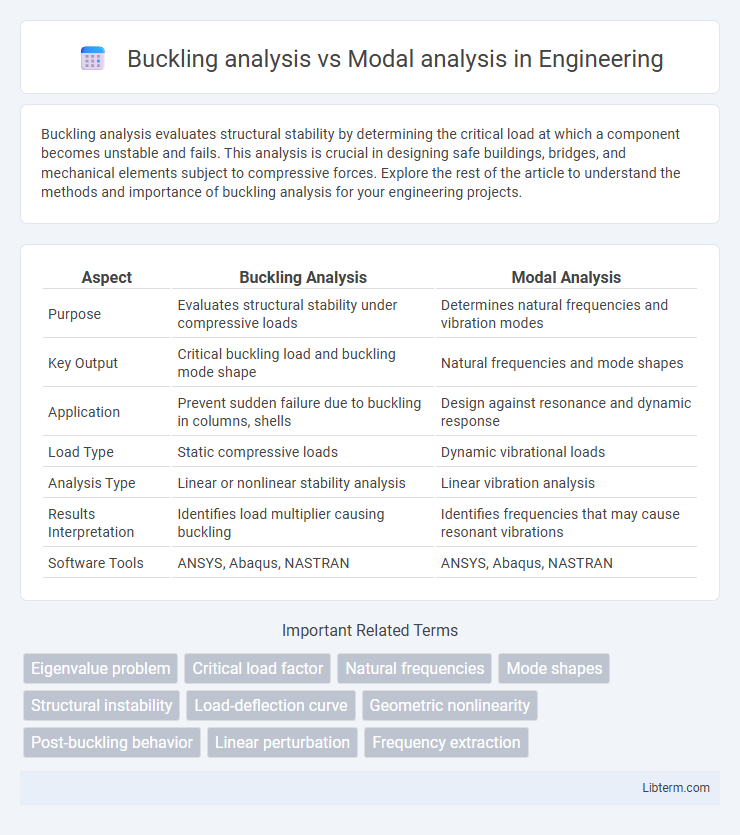Buckling analysis evaluates structural stability by determining the critical load at which a component becomes unstable and fails. This analysis is crucial in designing safe buildings, bridges, and mechanical elements subject to compressive forces. Explore the rest of the article to understand the methods and importance of buckling analysis for your engineering projects.
Table of Comparison
| Aspect | Buckling Analysis | Modal Analysis |
|---|---|---|
| Purpose | Evaluates structural stability under compressive loads | Determines natural frequencies and vibration modes |
| Key Output | Critical buckling load and buckling mode shape | Natural frequencies and mode shapes |
| Application | Prevent sudden failure due to buckling in columns, shells | Design against resonance and dynamic response |
| Load Type | Static compressive loads | Dynamic vibrational loads |
| Analysis Type | Linear or nonlinear stability analysis | Linear vibration analysis |
| Results Interpretation | Identifies load multiplier causing buckling | Identifies frequencies that may cause resonant vibrations |
| Software Tools | ANSYS, Abaqus, NASTRAN | ANSYS, Abaqus, NASTRAN |
Introduction to Structural Analysis Methods
Buckling analysis evaluates structural stability under compressive loads by determining critical load factors that cause sudden failure, essential for slender components prone to buckling. Modal analysis identifies natural vibration frequencies and mode shapes, crucial for predicting dynamic behavior and avoiding resonance in structural systems. Both methods are integral to structural analysis, providing complementary insights into static stability and dynamic response for safe and efficient design.
What is Buckling Analysis?
Buckling analysis evaluates the critical load at which structures experience sudden deformation or collapse due to instability under compressive stresses, mainly in columns or slender components. This structural analysis identifies the buckling load factor and corresponding buckling modes to ensure safe design limits and prevent catastrophic failure. Engineers utilize finite element methods to simulate buckling behavior, predicting how materials and geometry influence stability under axial loads.
Principles of Modal Analysis
Modal analysis evaluates the natural frequencies and mode shapes of a structure by solving the eigenvalue problem derived from the mass and stiffness matrices, enabling prediction of vibration characteristics under dynamic loading. It identifies resonance conditions and assesses structural response without applying external forces, crucial for designing against fatigue and dynamic failure. Unlike buckling analysis, which determines critical loads causing structural instability, modal analysis focuses on the inherent dynamic properties crucial for aerospace, automotive, and civil engineering applications.
Key Differences: Buckling vs Modal Analysis
Buckling analysis evaluates a structure's stability by determining the critical load at which it suddenly deforms or collapses, focusing on load-induced failure modes. Modal analysis identifies natural frequencies and mode shapes to assess dynamic behavior and vibration characteristics without considering load limits. The primary distinction lies in buckling analysis addressing structural stability under compressive loads, while modal analysis focuses on resonance and dynamic response properties.
Applications of Buckling Analysis
Buckling analysis is critical in structural engineering for assessing the load-carrying capacity and stability of columns, beams, and shells under compressive forces, preventing sudden failure due to buckling. It is extensively used in the design and safety evaluation of bridges, aerospace components, and offshore structures to predict critical buckling loads and optimize material usage. Unlike modal analysis, which investigates natural vibration modes and frequencies for dynamic behavior, buckling analysis specifically targets structural stability under static or slowly varying compressive loads.
Applications of Modal Analysis
Modal analysis is crucial in structural engineering for identifying natural frequencies and mode shapes, which helps predict a structure's response to dynamic loads such as earthquakes and wind. It enables the design of buildings, bridges, and mechanical components to avoid resonance and failures due to vibrations. Common applications include aerospace structures, vehicle chassis, and machine tool vibrations monitoring to ensure stability and performance.
Importance of Boundary Conditions
Boundary conditions critically impact the accuracy of both buckling analysis and modal analysis by defining how the structure is supported and restrained, influencing stability and dynamic response predictions. In buckling analysis, improper boundary conditions can lead to significantly underestimated critical loads, causing unsafe designs or over-conservatism. For modal analysis, boundary conditions directly affect natural frequencies and mode shapes, making precise definition crucial for reliable vibration and structural integrity assessments.
Interrelation Between Buckling and Modal Analysis
Buckling analysis evaluates the critical load at which a structure becomes unstable, while modal analysis identifies natural vibration frequencies and mode shapes. The interrelation lies in the fact that buckling loads can influence modal properties, causing shifts in natural frequencies and altering dynamic behavior before structural failure occurs. Understanding this interaction is crucial for designing safe structures that resist both dynamic excitations and stability loss.
Limitations of Each Analysis Method
Buckling analysis primarily addresses stability under compressive loads but does not provide information about dynamic behavior or natural frequencies, limiting its use in vibration-prone structures. Modal analysis identifies natural frequencies and mode shapes to predict dynamic response but cannot assess structural stability under critical load conditions like buckling. Combining both analyses is essential for comprehensive structural evaluation, as relying solely on one method may overlook critical failure modes or resonance issues.
Choosing the Right Analysis for Structural Design
Buckling analysis evaluates the critical load at which a structure becomes unstable and fails due to sudden deformation, essential for designing slender elements under compressive stress. Modal analysis determines natural frequencies and mode shapes, helping to predict dynamic behavior and avoid resonance in structures subjected to vibrations. Selecting the appropriate analysis depends on the structural conditions: buckling analysis is critical for compression-loaded components, while modal analysis is vital for structures exposed to dynamic or cyclic loading.
Buckling analysis Infographic

 libterm.com
libterm.com